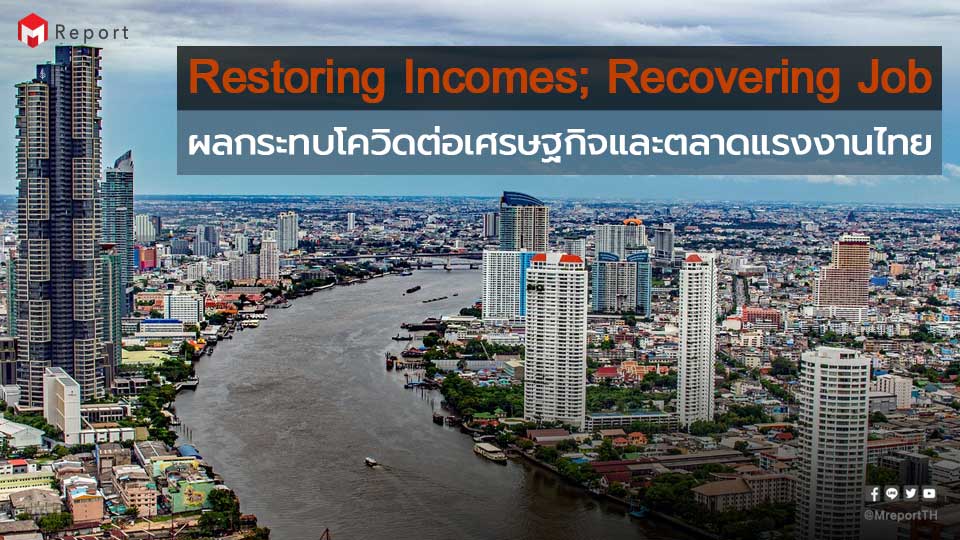
Thailand Economic Monitor January 2021: Restoring Incomes; Recovering Jobs
(World Bank Thailand. JANUARY 20, 2021.) COVID-19 has severely affected the Thai economy, which was already weakening even prior to the global outbreak. While signs of improvement have emerged in the most recent data, the second wave of COVID-19 cases could constrain domestic demand in the near-term.
The Thai economy is expected to have contracted by 6.5 percent in 2020.
| Advertisement | |
.jpg) |
|
Private consumption is expected to have contracted by 1.3 percent in 2020 due to the imposition of mobility restrictions and social distancing measures, and the resulting reductions in jobs and incomes.
Private investment is expected to have declined by 4.4 percent amid continued uncertainty around the medium-term outlook for exports and growth.
The external sector remains depressed. Services exports have suffered a severe contraction as international border restrictions remain in place and international tourism remains negligible. Goods exports have been hit by deteriorating external goods demand but recovered toward the end of 2020.
Supported by an easing of mobility restrictions and the provision of government stimulus, the economy saw a smaller contraction of -6.4 percent in Q3 2020 (yoy) compared to the -12.1 percent contraction in Q2. Partial indicators of consumption and investment continued to improve in October and November.
The contraction of 6.5 percent expected for the full-year 2020 has been revised upwards by 1.8 percentage points since the October 2020 East Asia and Pacific Economic Update, due to this stronger-than-expected performance in the second half of the year.
The financial sector has so far been able to weather the pandemic shock. However, increased corporate vulnerabilities and elevated levels of household debt pose significant risks as household debt in Thailand is the second highest in East Asia (at 80.2 percent of GDP in March 2020) and NPLs are particularly high for SMEs.
The policy response has acted to bolster economic activity and support the livelihoods of the most vulnerable.
Thailand has performed relatively well compared to its peers in the region in terms of the scale, speed, and targeting of its fiscal response, which has centered on a 1 trillion baht package to fund cash transfers, the medical response, and economic and social rehabilitation. New large-scale cash transfer programs have been established to support vulnerable groups who would not otherwise have been covered by existing social assistance mechanisms.
The implementation of measures to provide soft loans to SMEs as part of the overall pandemic response has proved challenging. The disbursement of these loans has fallen below expectations while overall credit growth to SMEs has slowed.
The fiscal deficit widened sharply as the government ramped up spending to mitigate the economic impacts of the COVID-19 on households and firms. The budgetary central government deficit expanded to 5.9 percent of GDP in FY2020 (year ended September), from 2.3 percent of GDP in FY2019, while government debt increased to 49.4 percent of GDP in September 2020.
Thailand’s economy is expected to recover gradually over the next two years, but the outlook remains highly uncertain.
Following an estimated contraction of 4.4 percent in 2020, global growth is projected to be 4.0 percent in 2021
Thailand’s economy is projected to rebound to 4.0 percent in 2021 and pick up further to 4.7 percent in 2022, underpinned by a recovery in domestic demand and supportive fiscal policy.
But Thailand’s economic outlook remains highly uncertain due to risks from external and domestic sources. If the new wave of infection in Thailand is not well contained, or if global cases continue to rise and progress on distributing a vaccine is slower than anticipated, economic activity could continue to be disrupted by social distancing measures and lockdowns. The premature removal of fiscal and financial relief could also hinder Thailand’s recovery.
There are also downside risks due to financial vulnerabilities, a resumption of trade tensions and supply-chain disruptions, and political unrest. COVID-19 may also have longer-term scarring impacts on potential output, including through its effects on the labor market.
This edition of the Thailand Economic Monitor provides an in-depth analysis of recent developments in Thailand’s labor market and discusses policies to drive a jobs recovery from COVID-19
The COVID-19 outbreak has created several additional challenges in the labor market. The primary impact has been a spike in unemployment, with a large increase among young people, and a widespread reduction in hours worked.
As a result of the pandemic, the unemployment rate doubled from 1.0 percent in the first quarter of 2019 to 2.0 percent in the second quarter of 2020, the highest level since 2009 with a particularly large increase for young people.
By the second quarter of 2020 there were 700,000 fewer jobs in aggregate than a year earlier, and 340,000 fewer than the previous quarter.
Employment losses were widespread across sectors with more significant losses in terms of numbers of jobs lost in Manufacturing and Wholesale and Retail, while the Agriculture sector acted as a safety net.
Hours worked fell by 5.7 percent for men and 7.2 percent for women between the first and second quarters of 2020, reflecting a spike in zero-hour workers and an increase in workers working fewer than 40 hours a week. The reduction in hours worked and other labor market adjustments resulted in a decline of private sector average monthly wages of 5.4 percent in the Agriculture sector and 1.9 percent outside of it.
By the third quarter, some of these impacts had moderated. The labor force participation rate increased in the third quarter and employers added nearly 850,000 jobs resulting in year-on-year job growth of more than 1 percent. This continued in the first two months of the fourth quarter.
Still, the unemployment rate remained elevated at the end of 2020, hours worked have not fully recovered, and several sectors including Manufacturing remain smaller than a year ago.
Thailand’s rapidly aging population means that the working age share of the population will decline. Absent other changes. this will decrease average annual growth in GDP per capita by 0.86 percent in the 2020s.
or the recovery from the COVID-19 outbreak to be sustainable in the context of Thailand’s rapidly aging population, good jobs will need to be created in high-productivity sectors associated with Thailand’s emerging knowledge economy. Productivity improvements and increases in the labor market participation of older people and women can counterbalance the negative growth effects of an aging population.
Policy recommendations for a sustained jobs recovery include:
In the short term:
(i) Deploy upskilling and reskilling training programs and provide financial support to help displaced workers get back to work.
(ii) A resurgence of the COVID-19 outbreak in Thailand could require a renewed focus on employment retention policies like wage subsidies that seek to keep workers in their jobs and job creation policies that could help make up for reduced working hours.
These programs should be followed by longer-term efforts which include:
(iii) Create a more demand-driven and results-oriented workforce development system by revamping skills training courses and modernizing employment services.
(iv) Promote employment in the care sector, particularly in the evolving market for aged care, which will require both lower skilled workers and highly trained specialists.
(v) Make childcare more accessible and decrease its cost to help increase female labor force participation.
(vi) Encourage firms to adopt flexible working arrangements for older people and invest in age-friendly workplaces, deploy performance-based compensation schemes and considering increasing the retirement age to extend the working lives of older people.







